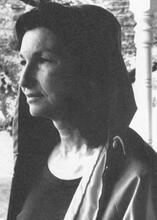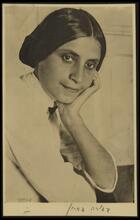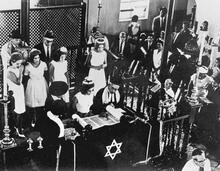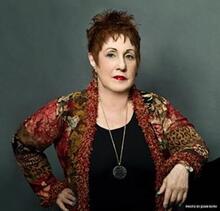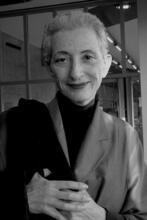Anita Diamant
Anita Diamant is author of The Red Tent (1997), made into an American television miniseries (2014), and four other novels. Her life experience dictated her non-fiction books about the entire lifecycle from birth to death; they are descriptive of contemporary Jewish practice. She sees them as not only “how-to” books but also “why to.” Diamant is a feminist, which to her means “the radical idea that women are human beings.” She self-identifies as a liberal Jew, which she sees as a “synthesis of tradition and modernity” shared in different ways by three movements: Reform, Conservative and Reconstructionist. Diamant helped to pioneer a global revival of the ancient tradition of mikveh and made it accessible and attractive to Jews of all descriptions.
Anita Diamant is a Jewish journalist and author who has written five novels and many self-help and guide books about modern Jewish life. Her best-known novel is The Red Tent (1997), made into an American television miniseries directed by Roger Young and starring Minnie Driver and Deborah Winger in 2014. She began as a journalist writing for magazines and newspapers in Boston. Her writings cover a wide variety of topics, ranging from medical ethics to essays about politics and popular culture.
Early Life and Education
Diamant was born in Brooklyn, New York, on June 27, 1951, to Helene and Maurice Diamant. She ascribes her “strong voice,'” or “healthy ego” to her mother and her literary side to her father, who read Jack London to her as a child. She has one daughter, Emilia Diamant.
Diamant’s parents moved to Newark, New Jersey, where Anita grew up. The family did not affiliate with a congregation until she was twelve years old, when her family moved to Denver, Colorado, where the family joined a Reform congregation and she became active in the movement’s youth group.
Diamant received her B.A. (1973) from Washington University in St. Louis with a degree in comparative literature and earned her M.A. (1975) in American literature from SUNY Binghamton University in upstate New York.
While still a student, Diamant was critical of the domination of the nascent feminist movement by white middle-class women. She wrote in a letter to off our backs, an early radical feminist journal: “The struggle of women against sexual repression is inextricably bound up with the struggles of all oppressed people. To separate ourselves from the rest of the oppressed world is to take part in their oppression to forget who we are!” (off our backs, 26).
Diamant identifies herself as a feminist, which she ironically defines as “the radical idea that women are human beings.” On her blog, Diamant writes how she was challenged and inspired by Virginia Woolf’s book A Room of One’s Own, which pointed to the absence of women’s voices in literature (anitadiamant.com, June 13, 2008). Diamant considered herself to be a product of the feminist revolution that changed the world and that her friendships with other women were influential in her life and thought.
Journalism Career
In 1975, Diamant moved to Boston and began a career in journalism. She served as an editor for Equal Times (1977-78), columnist and staff writer for the Boston Phoenix (1980-83), senior staff writer for Boston Magazine (1986-88), radio commentator for WBUR-FM (1981-82), food writer and contributing editor to the New England Monthly (1984-86), and columnist for the Boston Globe magazine (1988). She was honored with several awards for her journalism: The Clarion Award (1981); The New England Women's Press Association, Best Columnist Award (1982); The Award of Excellence (1983); and awards from The Massachusetts Division, American Cancer Society (1987, 1988). She was a fellow at the Casey Journalism Center for Children and Families (1994); an honorary visiting scholar at Radcliffe College’s Schlesinger Library (1994-95), and a visiting scholar in the Women's Studies Department at Brandeis University (1995-96).
Liberal Judaism
In Living a Jewish Life, Diamant describes liberal Judaism as a “synthesis of tradition and modernity” shared in different ways by three movements: Reform, Conservative, and Reconstructionist. All three movements ordain women as rabbis and moving Judaism from an “an all-male arena” to placing women at center stage. Diamant believes that feminism is consistent with being a Jewish woman and sees Judaism as revitalized by the “work and wisdom of Jewish women, which has led to new paradigms.” She writes, “Women’s inclusiveness and inclusion have been the model for the enfranchisement of all Jews, regardless of ability, sexual orientation, race, or religion of origin.” Diamant explores these ideas in her non-fiction books about Jewish life.
Jewish Self-Help/Guidebooks
Diamant describes her non-fiction books as descriptive of contemporary Jewish practice. She sees them as not only “how-to” books but also “why to.” What sets them apart from similar books is an approach that is respectful both of tradition and of contemporary insights and wisdom.
Diamant’s first book, The New Jewish Wedding (1985, revised 2017, and again 2019 as The Jewish Wedding Now), was inspired by Rabbi Larry Kushner, under whose tutelage her husband Jim Ball, a public relations professional, converted to Judaism in 1982, prior to their marriage in 1983. Diamant’s own life-cycle experiences often led to her guidebooks. Thus, the birth of their daughter Emilia led to The New Jewish Baby Book (1988), which was followed by many other guidebooks to Jewish life and the Jewish lifecycle: Living a Jewish Life (1991, revised 2009); Bible Baby Names: Spiritual Choices from Judeo-Christian Sources (1996); Choosing a Jewish Life: A Handbook for People Converting to Judaism and for Their Family and Friends (1997, revised 2017); Saying Kaddish: How To Comfort the Dying, Bury the Dead and Mourn as a Jew (1998, revised 2019), and How to Raise a Jewish Child (2000), with Karen Kushner (updated in 2008 as How to Be a Jewish Parent). Pitching My Tent (2003) is a collection of personal essays.
In her latest book, Period. End of Sentence: A New Chapter in the Fight for Menstrual Justice (2021), Diamant documents historical examples that illustrate the stigmas associated with the “curse” of menstruation and addresses practical issues such as repeals of taxation of tampons and pads. In highlighting the solidarity that came about because of this experience in various societies, she continues the thread of the Red Tent, which in her famous novel was a place of refuge and encouragement for menstruating women in biblical times.
The Novels
Diamant’s first novel was The Red Tent (1997). Although the first printing had modest sales, Diamant suggested that the publisher give away the remaining copies to female rabbis. This turned out to be a successful strategy, and with the help of book groups and word of mouth recommendations, the novel became a great success. Readers disagreed about whether the book was a A type of non-halakhic literary activitiy of the Rabbis for interpreting non-legal material according to special principles of interpretation (hermeneutical rules).midrashic interpretation, a re-telling of the biblical text, or a self-contained novel. Diamant herself sees it as a novel.
The Red Tent was a subversive book for its time. Diamant implied that goddess worship was better for women than the cold rules of the Jewish god (and was criticized for this). The narrator, Dinah, addresses her story to modern western women. The purpose of her telling her story is threefold: first the reader “craves words to fill the great silence that swallowed me.” Second, “remembering seems a holy thing.” And finally, “if we keep the stories of our ancestresses alive, they remain immortal. People who are loved never die—they remain in our hearts.” The title of the book implies that it is more than Dinah’s story; it is the story of our foremothers’ red tent, a retreat for women who are menstruating or after childbirth. It is the place of refuge in which a woman celebrates her womanhood and where she is free to worship her goddesses. It is not a place to which a woman is banished, or to which she flees. “Men knew nothing of the red tent or its ceremonies and sacrifices.” When Jacob, Dinah’s father finds out about what happens in the tent, he smashes all the women’s household gods and buries them. These goddesses cannot co-exist with his ancestral God, the god of Abraham and Isaac.
Diamant chose a contemporary setting for her second novel, Good Harbor (2001). This novel explores the importance of women’s friendships as a source of strength and support through difficult times, in this case, a diagnosis of breast cancer and a floundering marriage. Her third novel, The Last Days of Dogtown (2005), set in rural Massachusetts in the early 1800s, describes life in a poor community inhabited by widows, spinsters, freed Africans, and orphan children. Her fourth novel, Day After Night (2009), focuses on the experience of women who survived the Holocaust and make their way in 1945 to Palestine, where they are locked up in a British internment camp. The Boston Girl (2014) is the story of Addie Baum, born in 1900 to immigrant parents who were unprepared for and suspicious of America and its effect on their three daughters.
Diamant’s website includes a link to a CD entitled “Requited,” with music by Bert Seager and lyrics by Anita Diamant. The music includes elements of gospel, jazz, and art song and is performed by a five-piece ensemble with the vocalist Rebecca Shrimpton. Diamant writes: “Requited means ‘given in return,’ ‘completed,’ or ‘made whole’. Requited is how I felt creating these songs with Bert. It was also the most fun I’ve ever had as a writer.”
The Mikveh Project
In 2004, Diamant became the founding president of Mayyim Hayyim, Living Waters Community Mikveh and Education Center in Newton, Massachusetts, a reinvention of the ancient Jewish tradition of Ritual bathmikveh, ritual immersion in water. Among the seven basic principles that inform Mayyim Hayyim’s actions are a commitment to Jewish law, modesty, privacy, and love of the Jewish people. It is also a center that teaches Jewish rituals, values, and community. It welcomes all Jews who wish to learn and/or immerse, regardless of sexual orientation, physical/developmental ability, or background.
Diamant wrote in her essay “Why I want a Mikveh” that her interest stemmed from the experience of writing a book about conversion to Judaism and hearing how non-Orthodox Jews felt unwelcome in Orthodox mikvehs. She wanted the mikveh to be a welcoming place, “a place for laughter…a gracious [place] to celebrate with brides and grooms [and] a place for the newly Jewish to raise a glass of wine.” Diamant used her reputation as author of The Red Tent to help engage the local Jewish community to support a pluralistic mikveh open to all Jews. Although other feminists had written about using mikveh, Diamant helped to pioneer a global revival of this ancient tradition and made it accessible and attractive to all Jews. This is perhaps Diamant’s most important lasting legacy to the Jewish community.
Adebayo, Ayobami. “Anita Diamant Continues the Fight for Menstrual Justice.” New York Times, May 25, 2021.
Anita Diamant website; https://anitadiamant.com/
Baskin, Elizabeth. The Community Mikveh: An Invention of Tradition. Master’s Thesis, Brandeis University, 2012.
Diamant, Anita. “Letter.” off our backs (February-March 1972): 26.
Diamant, Anita. “Living Waters.” In Pitching My Tent: On Marriage, Motherhood, Friendship, and Other Leaps of Faith. New York, NY: Scribner Publishers, 2003.
Diamant, Anita. “Foreword: Holding Up Half the Sky: Feminist Judaism.” In New Jewish Feminism: Probing the Past, Forging the Future, edited by Rabbi Elyse Goldstein, xi-xiv. Woodstock VT: Jewish Lights Publishing, 2009.
Diamant, Anita. Period. End of Sentence: A New Chapter in the Fight for Menstrual Justice. New York, NY: Simon and Schuster, 2021.
Epstein, Nadine. “Anita Diamant: A Mikveh of Her Own: The Queen of Jewish Lifecycle Books and Author of the Best-Selling the Red Tent Is the Founder of the World’s First Freestanding Pluralistic Mikveh.” Moment 33, 4 (July-August 2008): 28-34; 52-55.
Graetz, Naomi. “Modern Midrash Unbound: Who’s Not Afraid of Goddess Worship?” Unlocking the Garden: A Feminist Jewish look at the Bible, Midrash and God. Piscataway NJ: Gorgias Press, 2005, 161-166.
Leveen, Adriane B. “A Tent of One’s Own: Feminist Biblical Scholarship, a Popular Novel, and the Fate of the Biblical Text.” In Women Remaking American Judaism, edited by Riv-Ellen Prell and David Weinberg, 83-106. Detroit: Wayne State University Press, 2007.
Sofian, Simone Lotven. “Popular Fiction and the Limits of Modern Midrash: The Red Tent by Anita Diamant.” Conservative Judaism 54, 3 (Spring 2002): 95-105.
Schantz, Jessica. “The Redemption of Dinah in Anita Diamant’s The Red Tent.” Women in Judaism: A Multidisciplinary Journal 5, 2 (Spring 2008).
Scolnic, Benjamin Edidin. “When Does Feminist Biblical Interpretation Become Anti-Semitic?” Women’s League Outlook, 72, 2 (2001): 27.
Wright, Terry R. “Rachel and Her Sisters: Anita Diamant.” In The Genesis of Fiction: Modern Novelists as Biblical Interpreters. New York: Routledge, 2007, 113-131.


